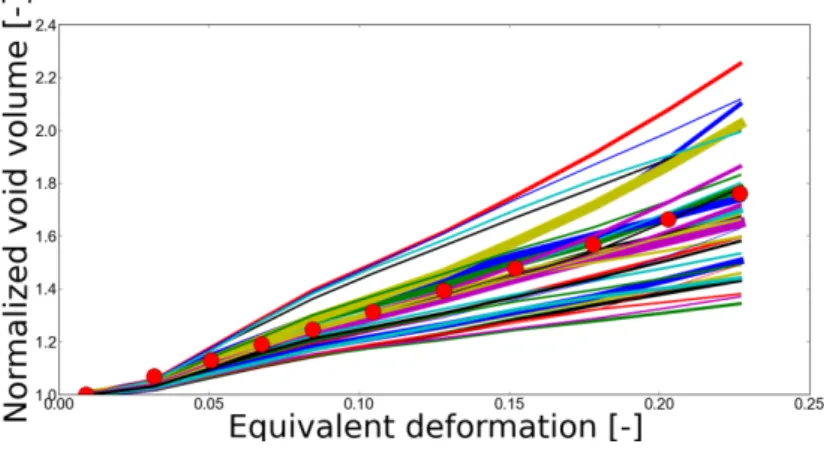HAL Id: hal-01504456
https://hal-mines-paristech.archives-ouvertes.fr/hal-01504456
Submitted on 12 Apr 2017
HAL is a multi-disciplinary open access
archive for the deposit and dissemination of
sci-entific research documents, whether they are
pub-lished or not. The documents may come from
teaching and research institutions in France or
abroad, or from public or private research centers.
L’archive ouverte pluridisciplinaire HAL, est
destinée au dépôt et à la diffusion de documents
scientifiques de niveau recherche, publiés ou non,
émanant des établissements d’enseignement et de
recherche français ou étrangers, des laboratoires
publics ou privés.
A study of the effect of microstructural heterogeneities
on ductile damage.
Victor-Manuel Trejo-Navas, Modesar Shakoor, Marc Bernacki, Pierre-Olivier
Bouchard
To cite this version:
Victor-Manuel Trejo-Navas, Modesar Shakoor, Marc Bernacki, Pierre-Olivier Bouchard. A study of the
effect of microstructural heterogeneities on ductile damage.. 3èmes Journées Matériaux Numériques,
Jan 2017, Tours, France. �hal-01504456�
A study of the effect of microstructural heterogeneities on ductile
damage
V. Trejo1, M. Shakoor1, M. Bernacki1 and P.O. Bouchard1
victor-manuel.trejo_navas@mines-paristech.fr
1 Mines ParisTech PSL Research University, CEMEF Centre de mise en forme des matériaux, CNRS UMR
7635, CS 10207 rue Claude Daunesse, 06904 Sophia Antipolis Cedex, France
Abstract
Accurate prediction of ductile fracture of metallic materials requires sufficient understanding of the underlying
micromechanical phenomena, especially if complex multiaxial and non-proportional loadings are to be considered. In this micromechanical study, real microstructures are submitted to realistic boundary conditions up to large plastic strains thanks to the combination of Laminography, Digital Volume Correlation and Finite Element Modelling. The obtained results evidence the effect of the microstructural heterogeneities on the ductile fracture process.
Introduction
A methodology developed for the study of the micromechanisms of ductile damage (void nucleation, growth and coalescence) for complex and heterogeneous microstructures up to large plastic strains is employed in this study. In this methodology, in-situ Synchrotron Radiation Computed Laminography (SRCL) (Centre des Matériaux, MINES ParisTech), Digital Volume Correlation (DVC) (Laboratoire de Mécanique et Technologie – École Normale Supérieure - Paris-Saclay) and Finite Element (FE) modelling (Centre de Mise en Forme de Matériaux, MINES ParisTech) are seamlessly coupled. In-situ SRCL tests provide three-dimensional images of the microstructure, and kinematic information is then obtained via DVC. A FE framework with advanced meshing capabilities is subsequently used in order to carry out micromechanical simulations thanks to the topological and kinematic information obtained by SRCL and DVC, respectively with the objective of studying the effect of the microstructural heterogeneities on the ductile fracture process.
Results
The described framework (SRCL-DVC-FE) was applied to a nodular cast iron specimen. This specimen has two laser-drilled holes of 1mm of diameter. Nodular cast iron was chosen because it provides strong contrast between the ferritic matrix and the graphite inclusions when observed via SRCL. This material also presents low levels of cohesive forces in the particle-matrix interface, which makes it possible to neglect them in the simulations. Since graphite inclusions are very soft with respect to the matrix, their mechanical contribution is not considered in the simulations, i.e., the particles are considered as voids. The mechanical behavior of the matrix is described with von Mises plasticity and isotropic hardening.
A section of the specimen along with the obtained plastic strain field is shown in Figure 1. Very good correspondence in the position of the deformed microstructural features is observed between the SRCL image and the simulation. Different localization bands with different orientations are predicted.
In Figure 2, the individual normalized void size evolution is presented for 53 voids in the domain. The line width of each curve in the figure is proportional to the corresponding initial void size. The absence of a clear trend between the initial void size and the final void growth hints at the complexity of the void growth due to the intervention of several microstructural variables.
Figure 1.(a) Section of the deformed microstructure of the and strain field obtained from FE simulation and (b) same
section at the onset of coalescence
Figure 2. Normalized void size evolution of 53 voids contained in the simulation domain
Conclusions
The micromechanisms of ductile damage were assessed via a SRCL-DVC-FE combined approach, with emphasis on the effect of the microstructural heterogeneities on the fracture process of a nodular cast iron specimen. Analyzing the effect of these heterogeneities can provide insight into the importance of usually simplified microstructural variables such as void shape and distribution, and help recognize limitations of void nucleation, growth and coalescence models, as well as behavior laws.
Conclusions
The authors would like to gratefulle thank the French ANR for funding the COMINSIDE project.
References
[1] T. F. Morgeneyer, L. Helfen, H. Mubarak and F. Hild. 3D digital volume correlation of synchrotron radiation laminography images of ductile crack initiation: an initial feasibility study Experimental Mechanics, vol. 53, n° 14, pp. 453-556, 2013..
[1] M. Shakoor, M. Bernacki, and P.-O. Bouchard. A new body-fitted immersed volume method for the modeling of ductile fracture at the microscale: Analysis of void clusters and stress state effects on coalescence. Engineering Fracture Mechanics 147 (2015): 398-417.
